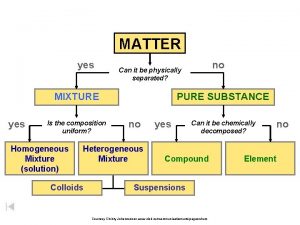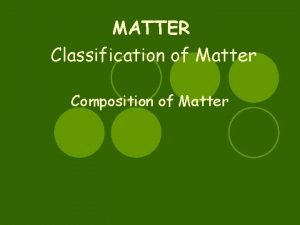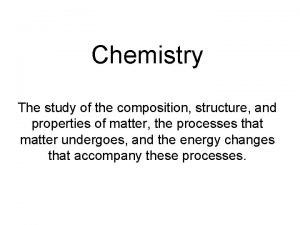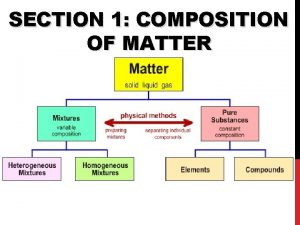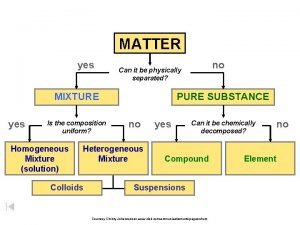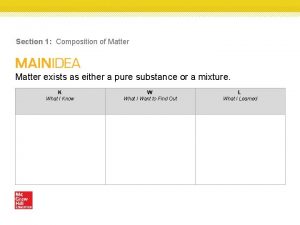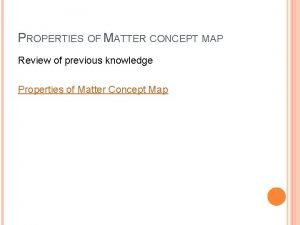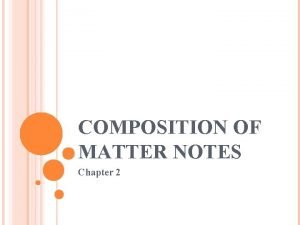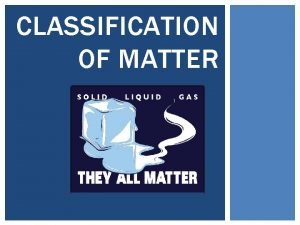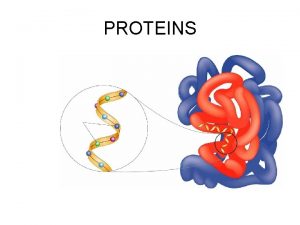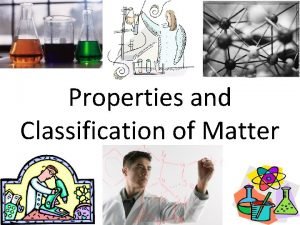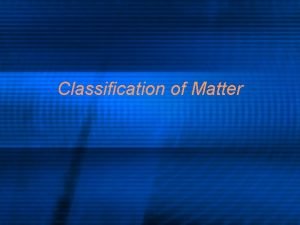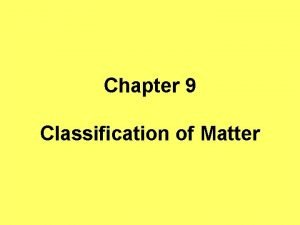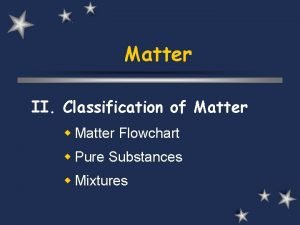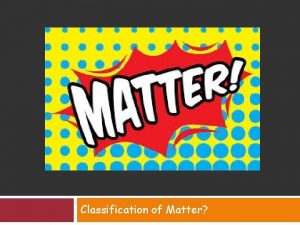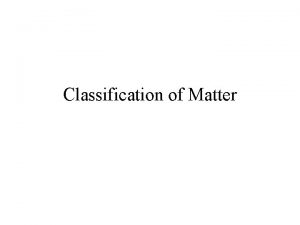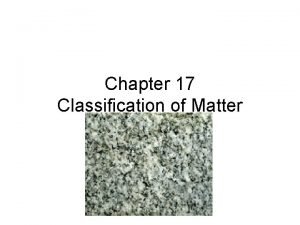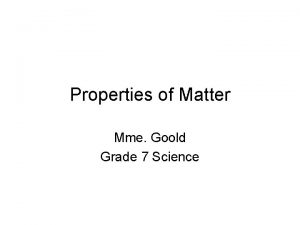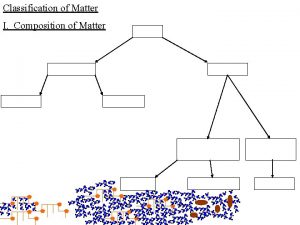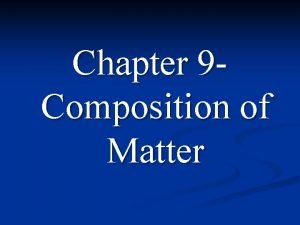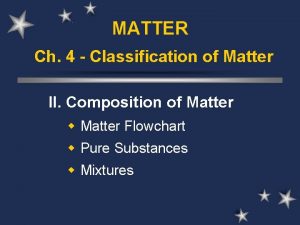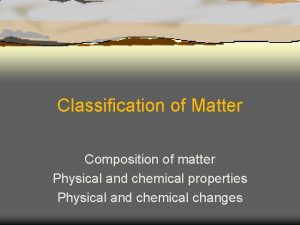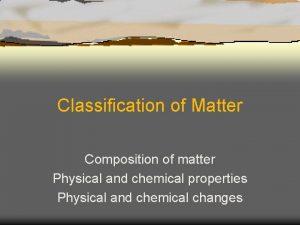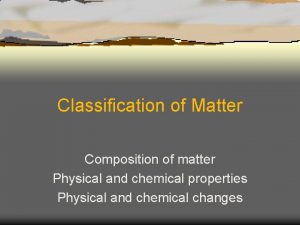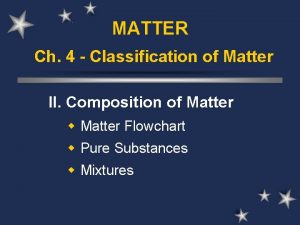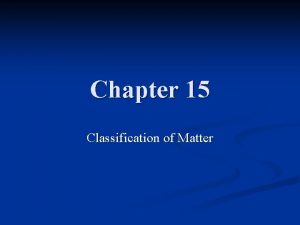MATTER Classification of Matter I Composition of Matter

































- Slides: 33

MATTER Classification of Matter I. Composition of Matter w Matter Flowchart w Pure Substances w Mixtures

A. Matter Flowchart MATTER yes MIXTURE yes Is the composition uniform? Homogeneous Mixture (solution) no Can it be separated by physical means? PURE SUBSTANCE no Heterogeneous Mixture yes Can it be decomposed by chemical means? Compound no Element

B. Pure Substances ö Element w matter composed of identical atoms w EX: copper

Periodic Table of Elements

B. Pure Substances ö Compound/ Molecule w matter composed of 2 or more elements in a fixed ratio w properties differ from those of individual elements w chemically combined w EX: salt (Na. Cl) or water (H 2 O)

Chemical Formulas ö Shows how many atoms of each element are in the substance. Example: C 16 H 10 N 2 O 2 is a blue dye. ö The number of atoms of each element is written after the element’s symbol as a subscript. ö If only one atom is present, no subscript is needed.

Chemical Formulas ö You try. C 12 H 22 O 11 How many atoms of each element are in this formula? C is for carbon. H is for hydrogen. O is for oxygen.

C. Mixtures ö Variable combination of 2 or more pure substances. ö Homogeneous Mixture (Solution) w even distribution of components w very small particles w particles never settle w EX: saline solution

C. Mixtures ö Heterogeneous Mixture w uneven distribution of components w Can physically separate w Colloids and Suspensions w EX: granite

C. Mixtures ö Colloid w medium-sized particles w Tyndall effect - particles scatter light (looks cloudy) w particles never settle w EX: milk

C. Mixtures ö Suspension w large particles w particles scatter light w particles will settle (needs to be shaken) w EX: fresh-squeezed lemonade

Law of Conservation of Mass and Energy ö Mass cannot be created nor destroyed ö Energy cannot be created nor destroyed; it can be transformed or transferred to other forms of energy.

w. MATTER Solids, Liquids, & Gases I. States of Matter w Kinetic Molecular Theory w Four States of Matter w Thermal Expansion

A. Kinetic Molecular Theory ö KMT w Tiny, constantly moving particles make up all matter. w The kinetic energy (motion) of these particles increases as temperature increases.

B. Four States of Matter ö Solids w low KE - particles vibrate but can’t move around w definite shape & volume w crystalline - repeating geometric pattern w amorphous - no pattern (e. g. glass, wax)

B. Four States of Matter ö Liquids w higher KE - particles can move around but are still close together w indefinite shape w definite volume

B. Four States of Matter ö Gases w high KE - particles can separate and move throughout container w indefinite shape & volume

B. Four States of Matter ö Plasma w very high KE - particles collide with enough energy to break into charged particles (+/-) w gas-like, indefinite shape & volume w stars, fluorescent light bulbs, TV tubes

C. Thermal Expansion ö Most matter expands when heated & contracts when cooled. ö Temp causes KE. Particles collide with more force & spread out. ö EX: thermostats (bimetallic strip)

w. MATTER Solids, Liquids, & Gases II. Changes in State w Phase Changes w Heating Curves

A. Phase Changes ö Melting w solid to liquid ö Freezing w liquid to solid melting point = freezing point

A. Phase Changes ö Vaporization (boiling) w liquid to gas at the boiling point ö Evaporation w liquid to gas below the boiling point ö Condensation w gas to liquid

A. Phase Changes ö Sublimation w solid to gas w EX: dry ice, freeze drying, iodine

A. Phase Changes

B. Heating Curves ö Kinetic Energy w motion of particles w related to temperature ö Potential Energy w space between particles w related to phase changes

B. Heating Curves w. Gas - KE w. Boiling - PE w. Liquid - KE w. Melting - PE w. Solid - KE

B. Heating Curves ö Heat of Fusion w energy required to change from solid to liquid w some attractive forces are broken

B. Heating Curves ö Heat of Vaporization w energy required to change from liquid to gas w all attractive forces are broken w EX: steam burns, sweating, and… the drinking bird w. HEATING CURVE

MATTER Classification of Matter II. Describing Matter w Physical Property w Physical Change w Chemical Property

A. Physical Property ö A characteristic of a substance that can be observed without changing its identity. w can be used to separate mixtures w EX: magnetism, density

B. Physical Change ö A change in the form of a substance without changing its identity. w properties remain the same w reversible w can be used to separate mixtures w EX: dissolving, grinding

C. Chemical Change ö A change in the identity of a substance. w properties change w irreversible w Signs: color change, formation of a gas/solid, release of light/heat w EX: burning, rusting

D. Chemical Property ö A characteristic that indicates whether a substance can undergo a specific chemical change. w EX: flammability, reactivity
 Classification of matter section 1 composition of matter
Classification of matter section 1 composition of matter Classification of matter section 1 composition of matter
Classification of matter section 1 composition of matter Composition of matter section 1
Composition of matter section 1 Composition uniform
Composition uniform Composition of matter which depends on temperature.
Composition of matter which depends on temperature. Study of the composition structure and properties
Study of the composition structure and properties Composition of matter section 1
Composition of matter section 1 What is a uniform composition
What is a uniform composition Flow chart for classifying matter
Flow chart for classifying matter What is composition in matter
What is composition in matter Section 1 composition of matter answer key
Section 1 composition of matter answer key Classifying matter concept map
Classifying matter concept map Composition of matter flow chart
Composition of matter flow chart Number of proton
Number of proton Properties of solid liquid and gas
Properties of solid liquid and gas Mixture
Mixture Protein elements
Protein elements Gray matter vs white matter
Gray matter vs white matter Chapter 2 matter section 1 classifying matter answer key
Chapter 2 matter section 1 classifying matter answer key Dural septa
Dural septa Gray matter and white matter
Gray matter and white matter What is grey matter
What is grey matter Energy naturally flows from warmer matter to cooler matter.
Energy naturally flows from warmer matter to cooler matter. Classification and properties of matter
Classification and properties of matter Classification of matter worksheet
Classification of matter worksheet Classification of matter flow chart
Classification of matter flow chart Graphic organizer matter classifications
Graphic organizer matter classifications Classifying matter quiz
Classifying matter quiz Classifying matter flow chart
Classifying matter flow chart Overview classification of matter
Overview classification of matter Matter classification
Matter classification Pizza classification of matter
Pizza classification of matter Granite classification of matter
Granite classification of matter Matter and materials grade 7
Matter and materials grade 7



